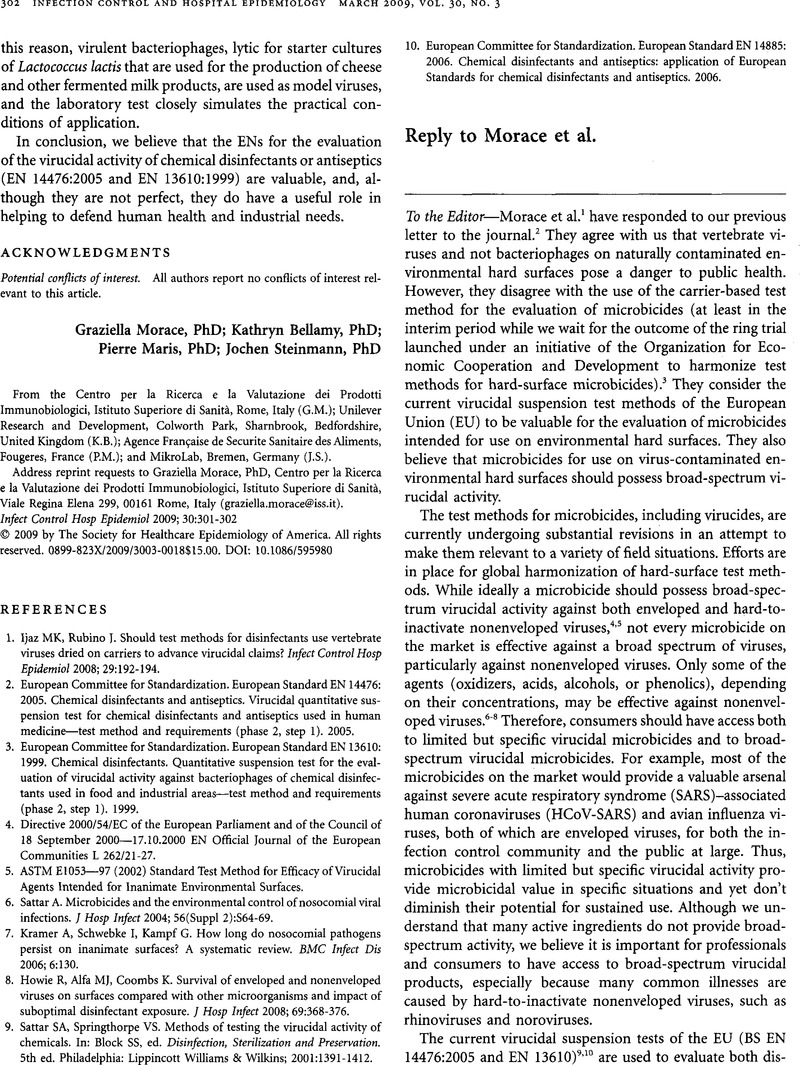No CrossRef data available.
Article contents
Reply to Morace et al
Published online by Cambridge University Press: 02 January 2015
Abstract
An abstract is not available for this content so a preview has been provided. As you have access to this content, a full PDF is available via the ‘Save PDF’ action button.

- Type
- Letters to the Editor
- Information
- Copyright
- Copyright © The Society for Healthcare Epidemiology of America 2009
References
1.Morace, G, Bellamy, K, Maris, P, Steinmann, P. Evaluation of the virucidal activity of disinfectants and antiseptics: the European point of view. Infect Control Hosp Epidemiol 2009;30:301–302.Google Scholar
2.Ijaz, MK, Rubino, J. Should the test methods for efficacy of disinfectants use vertebrate viruses dried on carriers to advance virucidal claims substantiation in public health arena? Infect Control Hosp Epidemiol 2008;29:192–194.CrossRefGoogle Scholar
3.Organization for Economic Cooperation and Development. OECD efficacy workshop on certain antimicrobial biocides, April 22-24, 2002, Arlington, Virginia, USA, workshop summary report. Arlington, VA: Organization for Economic Cooperation and Development; 2002.Google Scholar
4.Sattar, SA. Hierarchy of susceptibility of viruses to environmental surface disinfectants: a predictor of activity against new and emerging viral pathogens. J AOAC Int 2007;90:1655–1658.Google Scholar
5.Springthorpe, VS, Sattar, SA. Carrier tests to assess microbicidal activities of chemical disinfectants for use on medical devices and environmental surfaces, J AOAC Int 2005;88:182–201.Google Scholar
6.Prince, HN, Prince, DL. Principles of viral control and transmission. In: Block, SS, ed. Disinfection, Sterilization and Preservation. Philadelphia: Lea & Febiger; 2001:543–571.Google Scholar
7.Fraise, AP, Lambert, PA, Maillard, JY, eds. Russell, Hugo, and Ayliffe's Principles and Practice of Disinfection, Preservation and Sterilization. Victoria, Australia: Blackwell Publishing; 2004:272–323.Google Scholar
8.Rutala, WA, Weber, DJ, Healthcare Infection Control Practices Advisory Committee (HICPAC). Guideline for disinfection and sterilization in healthcare facilities, 2008. 2008. Available at: http://www.cdc.gov/ncidod/dhqp/pdf/guidelines/Disinfection_Nov_2008.pdf. Accessed December 23, 2008.Google Scholar
9.British Standards Institution. BS EN 14476:2005: Chemical Disinfectants and Antiseptics—Virucidal Quantitative Suspension Test for Chemical Disinfectants and Antiseptics Used in Human Mediane—Test Method and Requirements (Phase 2, Step 1). London, England: British Standards Institution, 2005.Google Scholar
10.European Committee for Standardization. EN 13610: Chemical Disinfectants—Quantitative Suspension Test for the Evaluation of Virucidal Activity Against Bacteriophages of Chemical Disinfectants Used in Food and Industrial Areas—Test Method and Requirements (Phase 2, Step 1). Brussels, Belgium: Committee for European Standardization, 1999.Google Scholar
11.ASTM International. ASTM E1053—97: Standard Test Method for Efficacy of Virucidal Agents Intended for Inanimate Environmental Surfaces. West Conshohocken, PA: ASTM International, 2002.Google Scholar
12.Parry, J. SARS virus identified, but the disease is still spreading. BMJ 2003;326:897.Google Scholar
13.Vijayanand, P, Willems, E, Woodhead, M. Severe acute respiratory syndrome (SARS): a review. Clin Med 2004;4:152–160.Google Scholar
14.Ligon, BL. Avian influenza virus H5N1: a review of its history and information regarding its potential to cause the next pandemic. Semin Pediatr Infect Dis 2005;16:326–35.Google Scholar
15.Canadian General Standards Board. CAN/CGSB-2.161-M97: Assessment of Efficacy of Antimicrobial Agents for Use on Environmental Surfaces and Medical Devices. Gatineau, Quebec: Canadian General Standards Board, 1997.Google Scholar
16.Therapeutic Goods Administration. Guidelines for the evaluation of ster-ilants and disinfectants. Canberra, Australia: Therapeutic Goods Administration, 1998.Google Scholar
17.United States Environmental Protection Agency. Efficacy data requirements: virucides. Available at: http://www.epa.gov/oppad001/dis_tss _docs/dis—07.htm. Accessed February 4, 2009.Google Scholar


